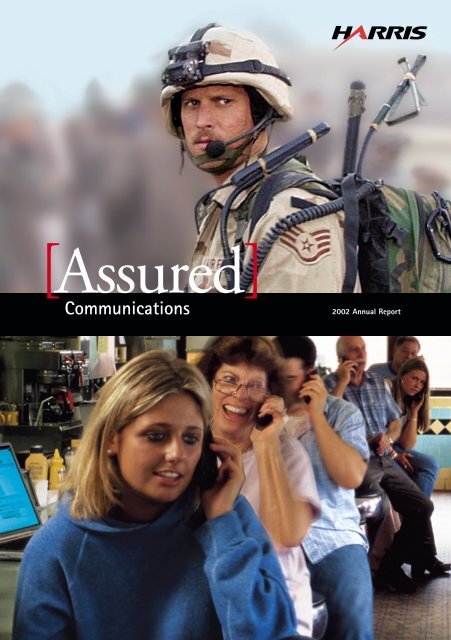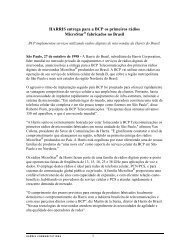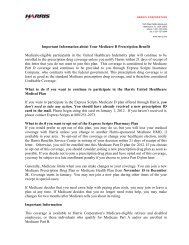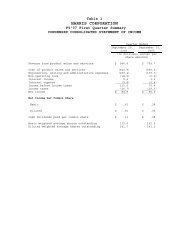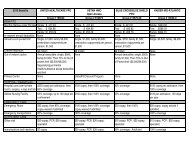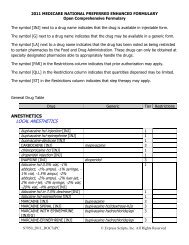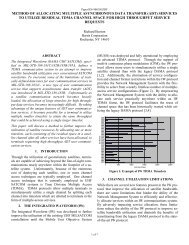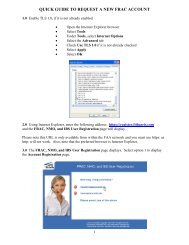Harris 2002 Annual Report
Harris 2002 Annual Report
Harris 2002 Annual Report
You also want an ePaper? Increase the reach of your titles
YUMPU automatically turns print PDFs into web optimized ePapers that Google loves.
[Assured]<br />
Communications<br />
<strong>2002</strong> <strong>Annual</strong> <strong>Report</strong>
Financial Highlights<br />
Dollars in millions except per share amounts<br />
<strong>2002</strong> (1) 2001 (2)<br />
Revenues $1,875.8 $1,955.1<br />
Net Income 82.6 21.4<br />
Per Share Net Income 1.25 .32<br />
Return on Revenues 4.4% 1.1%<br />
Return on Equity 7.3% 1.7%<br />
Diluted Average Shares Outstanding (Millions) 66.3 67.0<br />
Number of Record Shareholders 8,834 9,318<br />
Stock Price Performance*<br />
Fiscal Year Ending June 28, <strong>2002</strong><br />
HARRIS +31.73%<br />
DJIA -12.75%<br />
NASDAQ -31.90%<br />
S&P 500 -19.96%<br />
Russell 2000 -7.17%<br />
*Source: Bloomberg.com<br />
GOVERNMENT<br />
COMMUNICATIONS<br />
<strong>Harris</strong> conducts advanced research<br />
studies, develops prototypes, and<br />
produces, integrates, and supports<br />
state-of-the-art, highly<br />
reliable communications and<br />
information systems that solve<br />
the mission-critical communications<br />
challenges of its military<br />
and government customers. This<br />
business also provides the technology<br />
base for the company’s<br />
diverse commercial businesses.<br />
RF<br />
COMMUNICATIONS<br />
<strong>Harris</strong> is a leading worldwide<br />
supplier of tactical radio<br />
communications products,<br />
systems, and networks to military<br />
and government organizations,<br />
and a provider of high-grade<br />
encryption solutions. These<br />
solutions address the demanding<br />
requirements of U.S., NATO, and<br />
Partnership for Peace forces, as<br />
well as government agencies<br />
and embassies around the world.<br />
Business Segments<br />
BROADCAST<br />
COMMUNICATIONS<br />
<strong>Harris</strong> is the leading supplier<br />
of broadcast products and<br />
end-to-end systems for delivery,<br />
automation, and management<br />
of audio, video, and data. Setting<br />
the pace in the transition from<br />
analog to digital technology,<br />
<strong>Harris</strong> offers a complete range<br />
of studio, program transport,<br />
and transmission products<br />
and systems.<br />
Percent Revenue By Business Segment<br />
3%<br />
15%<br />
19%<br />
49%<br />
14%<br />
(1) Results for fiscal <strong>2002</strong> include a $6.8 million after-tax gain on the sale of our<br />
minority interest in our GE <strong>Harris</strong> Energy Control Systems, LLC joint venture, a<br />
$6.6 million after-tax write-down of our investment interest in Terion, Inc., and a<br />
$2.4 million after-tax write-down of marketable securities.<br />
(2) Results for fiscal 2001 include an after-tax charge of $73.5 million for the<br />
write-off of purchased in-process research and development, a $21.7 million<br />
after-tax gain on the sale of our minority interest in our GE-<strong>Harris</strong> Railway<br />
Electronics, LLC joint venture, a $13.1 million after-tax write-down of<br />
marketable securities, and goodwill amortization of $14.4 million after tax.<br />
MICROWAVE<br />
COMMUNICATIONS<br />
<strong>Harris</strong> is the largest supplier<br />
of microwave radio systems in<br />
North America and a global<br />
leader in broadband wireless<br />
solutions to cellular, PCS, and<br />
private telecom networks. Its<br />
product line, the broadest in<br />
the industry, includes microwave<br />
and millimeter wave systems<br />
for point-to-point and pointto-multipoint<br />
architectures.<br />
Government<br />
Government Communications<br />
RF Communications<br />
Broadcast<br />
Broadcast Communications<br />
Telecommunications<br />
Microwave Communications<br />
Network Support<br />
NETWORK<br />
SUPPORT<br />
<strong>Harris</strong> delivers management,<br />
test, and maintenance products,<br />
systems, and software for multivendor,<br />
multiprotocol networks<br />
of public and private communications<br />
service providers.<br />
Solutions address the needs of<br />
operations, maintenance, and<br />
installation professionals in<br />
telecommunications, broadcast,<br />
and defense markets around<br />
the world.
Assured Communications: For many years, the engineering community within<br />
<strong>Harris</strong> has characterized the value proposition of our products and systems as<br />
“assured communications.” Our equipment assures that soldiers in harm’s way<br />
are never out of touch, that TV and radio stations don’t go off the air, and that<br />
voice and data networks are never offline. In record numbers, old and new<br />
customers are trusting <strong>Harris</strong> to help them perform the increasingly complex<br />
task of communications.<br />
[Letter]<br />
To Shareholders<br />
Economic trends and other events have not been positive over the past 12 months. However, the restructuring<br />
of <strong>Harris</strong>, initiated three years ago, has positioned the company to succeed even in these troubled<br />
times. Our products and systems were used effectively in the recovery efforts following September 11th<br />
and are in great demand for the ongoing War on Terrorism. Our digital products are leading the charge<br />
to a new era in TV and radio broadcasting. The company’s diversified mix of businesses is helping to ensure<br />
that our telecom businesses have the stability to survive an extended market downturn and to emerge from<br />
that cycle even stronger.<br />
The company’s results for fiscal <strong>2002</strong> were solid, given the very difficult market environment<br />
for communications equipment companies. Results in our government, tactical radio, and broadcast<br />
businesses were strong. Market weakness in our telecom businesses was partially offset by on-going<br />
cost-cutting efforts. Overall, sales declined a modest 4 percent compared to the prior year, but net<br />
income grew to $82.6 million (1) (see footnote on previous page).<br />
Government Communications Systems<br />
The Government Communications Systems segment had strong gains in revenue and<br />
income as a result of increased defense spending and <strong>Harris</strong>’ expertise in developing<br />
critical communications systems. Fiscal <strong>2002</strong> segment sales were $924 million and<br />
grew 9 percent, compared to the prior year. Income increased 21 percent. The<br />
long-term outlook for this business has strengthened greatly. The business provides<br />
airborne, spaceborne, and ground communications systems for defense and other<br />
government agencies. This segment is experiencing a remarkable contract win rate and<br />
continues to benefit from performance incentives and from lower operating costs.<br />
Fiscal <strong>2002</strong> orders in the segment increased 10 percent and exceeded sales. During<br />
the year, the company won communications systems contracts across a broad base<br />
of programs, including Ballistic Missile Defense, weather data systems for the<br />
FAA, ground communications terminals for defense, key military aircraft<br />
platforms, and the Army’s Multiple Launch Rocket System.<br />
Phillip W. Farmer<br />
Chairman of the Board,<br />
President and<br />
Chief Executive Officer
Letter To Shareholders<br />
2<br />
The largest wins during the year included the selection of <strong>Harris</strong> to provide avionics equipment<br />
on the Joint Strike Fighter, a program valued at approximately $2 billion over the next 20 years, and a<br />
$200 million contract with a new customer, the U.S. Census Bureau. <strong>Harris</strong> will provide the Census<br />
Bureau with a nationwide computer database of addresses and locations where people live and work.<br />
The good news continued following the close of the fiscal year. In the first quarter of fiscal 2003,<br />
<strong>Harris</strong> won the largest contract in its history. The company will modernize telecommunications for the<br />
FAA in a 15-year program that has an initial value of $1.7 billion, with the potential to reach $3.5 billion<br />
as options are exercised. The FAA contract, combined with the company’s second quarter fiscal <strong>2002</strong><br />
win of a $2 billion position on the Joint Strike Fighter, represent the two largest programs in the<br />
company’s history.<br />
In the first quarter of fiscal 2003, <strong>Harris</strong> has been selected for several high-profile programs in<br />
what has been an unprecedented period of contract wins for our government business. In July and<br />
August <strong>2002</strong>, <strong>Harris</strong> secured positions on government programs with a combined potential value of<br />
more than $2.5 billion, and new opportunities continued to surface as budgets for key government<br />
customers increase to address defense and homeland security initiatives.<br />
RF Communications<br />
The RF Communications segment performed brilliantly once again, setting new records in all categories.<br />
Fiscal <strong>2002</strong> sales were $258 million and increased 16 percent compared to the prior year. Income soared<br />
59 percent, and orders almost doubled. <strong>Harris</strong>’ Falcon ® II family of secure tactical radio systems provides<br />
advanced communications for U.S., NATO, and Partnership for Peace forces, and is being used with great<br />
success in the War on Terrorism around the globe.<br />
The business began fiscal <strong>2002</strong> with its largest win ever when it was selected to provide 10,000 HF<br />
radios for the United Kingdom’s Bowman Tactical Radio Programme. The five-year contract has a value of<br />
more than $200 million. Bowman is one of the most important land-based military projects in recent U.K.<br />
history and positions <strong>Harris</strong> to expand its tactical radio footprint throughout Europe.<br />
At the end of the fiscal year, RF Communications won a significant position on another huge<br />
program that the Department of Defense calls its “Radio of the Future” – the Joint Tactical Radio System<br />
(JTRS). <strong>Harris</strong> was selected as a subcontractor to Boeing and expects to provide more than $500 million<br />
in system design, development, and production for the $4 billion first “Cluster” of a four-cluster JTRS<br />
development program that will provide advanced radio communications for all U.S. military forces.<br />
RF Communications also plans to bid on the JTRS Clusters 2-4, which will be awarded over the next<br />
12-24 months. The remaining Clusters have a total value of approximately $5 billion.<br />
The long-term outlook for the RF Communications business has never been brighter.<br />
Broadcast Communications<br />
The Broadcast Communications segment continued steady growth in fiscal <strong>2002</strong>. <strong>Harris</strong> solidified its<br />
leadership position in helping U.S. TV broadcasters make the transition to digital standards. The business<br />
had fiscal <strong>2002</strong> sales of $355 million, increasing 5 percent over record results<br />
in the prior year. Income, also a new record, grew 6 percent compared to fiscal<br />
2001. While sales from the digital rollout were robust, disappointing<br />
advertising revenues, resulting from the economic slowdown, did prompt some<br />
broadcasters to delay purchases of automation and studio systems during the<br />
year, limiting sales for those <strong>Harris</strong> product lines.<br />
In the fourth quarter, broadcast industry momentum was evident as<br />
<strong>Harris</strong> booked orders surpassing $100 million. We saw a surge in digital<br />
equipment purchases by non-commercial TV stations – PBS stations – which<br />
have begun their own scramble to meet the FCC digital deadline for PBS<br />
stations set for May 2003.<br />
The FCC has remained steadfast on its analog to digital conversion<br />
schedule and, by mid-summer, approximately half of the nation’s 1,600<br />
International vs.<br />
Domestic Business<br />
(percent of revenues)<br />
International 22%<br />
Domestic<br />
78%
oadcasters had ordered equipment that would allow them to meet at least the minimum first-step<br />
requirements of the FCC’s mandated rollout schedule. The good news is that strong market opportunities<br />
lie ahead as half of the domestic digital equipment volume has yet to be ordered. In addition, the international<br />
market rollout of digital equipment is still in its early stages.<br />
Looking ahead to fiscal 2003, we expect the continuation of the digital TV transition, and the beginning<br />
of the transition to digital radio standards. <strong>Harris</strong> helped to develop the new standards for radio and has<br />
introduced a new transmitter and other products for the digital transition.<br />
Microwave Communications<br />
International markets for telecommunications equipment continued to decline during fiscal <strong>2002</strong>. The<br />
primary problem was the absence of capital resources to finance the build-out of cellular networks. Fiscal<br />
<strong>2002</strong> sales were $289 million in our Microwave Communications segment, declining 33 percent compared to<br />
the prior year, and the business had a loss of $17.4 million. The North American market was the only bright<br />
spot, with sales remaining healthy. International sales were down 48 percent. We remain confident in the<br />
fundamentals of the microwave business and its eventual return to growth. Near term, we continue to reduce<br />
costs to cope with the current international market weakness.<br />
In fiscal <strong>2002</strong>, we introduced next-generation microwave radios that should have great implications for<br />
the long-term success of this business. Our point-to-multipoint (PMP) products, which provide last mile<br />
wireless voice and data services, are finding growing acceptance in international markets. During the year,<br />
<strong>Harris</strong> won three contracts for its PMP products in Malaysia, Greece, and Sri Lanka. The products provide<br />
toll-quality voice capability and high-speed Internet connection. We believe these initial contracts will<br />
lead to future orders in international markets.<br />
Network Support<br />
The Network Support segment saw sales drop sharply in fiscal <strong>2002</strong> to $57 million, down 53 percent from<br />
the prior year, and the business suffered an operating loss of $10.3 million. Capital spending by the U.S.<br />
Regional Bell Operating Companies (RBOCs) remained depressed, significantly lowering sales of our<br />
industry-leading telecom tools and test-set products. Demand for our network management system,<br />
NetBoss™, continued to decline due to significantly lower capital spending for telecom software worldwide.<br />
Although spending by the RBOCs remains very low, <strong>Harris</strong> has introduced a new line of digital test<br />
sets that has been standardized by the RBOCs and should provide a good stream of revenue when equipment<br />
purchases return to historical levels. In addition, the company will soon complete the first installation of<br />
its new enterprise solution, and NetBoss is expected to be used in several major programs won by our<br />
Government, Broadcast, and Microwave Communications<br />
businesses, which should help to improve results in our<br />
Network Support business.<br />
Strong Cash Flow, Low Debt<br />
Cash flow from operations was a positive $207 million<br />
for fiscal <strong>2002</strong>, versus a net use of cash by operations of<br />
$27 million in the prior year. All five business segments<br />
generated cash during the year. <strong>Harris</strong> reduced debt by<br />
$111 million, and at year-end had a debt-to-capital ratio<br />
of 21.2 percent, versus 27.3 percent at the end of the<br />
prior year. The improved cash flow position results in<br />
large part from working capital reduction programs across<br />
all business segments. The company’s positive cash flow<br />
position and strong balance sheet provide <strong>Harris</strong> with<br />
the flexibility to manage the company from a proactive<br />
position through a variety of economic cycles.<br />
Corporate Policy Committee<br />
(Left to Right) Bryan R. Roub, Senior Vice President and CFO;<br />
Richard L. Ballantyne, Vice President, General Counsel and Corporate<br />
Secretary; Phillip W. Farmer, Chairman and CEO; Nick E. Heldreth, Vice<br />
President, Human Resources and Corporate Relations<br />
3
Letter To Shareholders<br />
4<br />
Dividend Increase<br />
At its August <strong>2002</strong> meeting, the Board of Directors declared a quarterly dividend of 8 cents per share,<br />
which increases the previous quarterly dividend of 5 cents per share by 60 percent. The increase in the<br />
cash dividend brings the annual rate to 32 cents per share, compared to the previous rate of 20 cents per<br />
share. The increase in the quarterly payout results from the company’s solid financial performance in fiscal<br />
<strong>2002</strong>, positive cash flow from operations, and an improving business outlook. We are pleased to enhance<br />
shareholder value by increasing the total yield on the company’s common shares.<br />
Outlook<br />
Fiscal 2003 has begun on several upbeat notes with two big wins in our Government Communications<br />
Systems business. We anticipate further good news in both our Government Communications and RF<br />
Communications businesses. In our Broadcast business, we intend to continue to lead the digital transition<br />
in TV and radio in the U.S. and around the world. The company’s diversified mix of businesses is allowing<br />
us to overcome the current downturn in telecommunications, while continuing to provide our shareholders<br />
with a good return on their investment in <strong>Harris</strong>. For fiscal 2003, we expect to see continued growth in<br />
earnings driven by our leadership positions in key market segments.<br />
Board of Directors<br />
During the fiscal year, <strong>Harris</strong> elected two new directors with outstanding experience and management depth.<br />
David B. Rickard, 55, is the executive vice president and chief financial officer of CVS Corporation, the<br />
nation’s largest drugstore company. Lewis Hay III, 47, is chairman, president, chief executive officer, and former<br />
chief financial officer of FPL Group, Inc., one of the nation’s largest providers of electricity-related services.<br />
John T. Hartley retired from the Board in March. He joined <strong>Harris</strong> in 1956 as a research engineer,<br />
was named chief executive officer in 1986, and chairman of the board in 1987. We thank Jack for his vast<br />
contributions and steadfast dedication to the company for more than 46 years.<br />
Public Trust<br />
In closing, I’d like to acknowledge what is being described as a general lack of confidence in the way many<br />
public companies are being operated. While I believe that the vast majority of U.S. companies are operated<br />
with the best interests of shareholders in mind, I will restrict my comments to <strong>Harris</strong>.<br />
The senior management team of <strong>Harris</strong> is extremely mindful of the trust that shareholders, customers,<br />
employees, and suppliers place in the company, and we operate the company accordingly. We believe our<br />
accounting and business conduct practices adhere to both the letter and spirit of the law.<br />
We also believe our corporate governance principles are above reproach. Our Board of Directors is<br />
90 percent controlled by independent outside members. I am the only <strong>Harris</strong> employee on the 10-member<br />
board. The Audit, Corporate Governance, Management Development and Compensation, and Business<br />
Conduct committees have only independent directors, and they always have. We have an outstanding<br />
Board that is dedicated to the interests of all shareholders.<br />
There is a reason why <strong>Harris</strong> has been in business for 107 years. We understand the rules and we<br />
adhere to them.<br />
Sincerely,<br />
Phillip W. Farmer<br />
Chairman of the Board,<br />
President and Chief Executive Officer August 24, <strong>2002</strong>
[<strong>Harris</strong>]<br />
<strong>Harris</strong> will benefit from a<br />
sustained buildup in U.S.<br />
Government spending, the<br />
continuing rollout of digital<br />
broadcast equipment<br />
worldwide, and the eventual<br />
rebound of telecom markets.<br />
5
[Government]<br />
Communications<br />
<strong>Harris</strong> provides highly reliable communications<br />
and information systems that solve the<br />
mission-critical challenges of its defense<br />
and other government customers.<br />
Robert K. Henry<br />
President,<br />
Government Communications Systems
To Catch<br />
A Crook<br />
Crime Information:<br />
Millions of pieces of law<br />
enforcement information<br />
are continuously updated<br />
and stored in “information<br />
silos” like the one<br />
pictured here.<br />
[Assured Communications]<br />
At the FBI’s National Crime Information Center<br />
in Clarksburg, West Virginia<br />
The FBI’s National Crime Information Center (NCIC) was established in 1967<br />
to assist federal, state, and local criminal justice agencies in positively identifying<br />
suspected criminals. The NCIC features a computerized index of more than 39 million<br />
records on fugitives, missing persons, and stolen property. It is available over secure<br />
telecom lines to 80,000 law enforcement agencies and 738,000 law enforcement<br />
officers, 24 hours a day. For example, when an officer stops an individual for a traffic<br />
violation, a combination of the license plate number, auto description, or occupant’s<br />
name and date of birth is matched against the NCIC database in less than a second.<br />
A growing number of patrol vehicles now have laptop computers and fingerprint<br />
scanners, which allow officers to electronically receive mug shots and to match<br />
fingerprints against those in the NCIC database.<br />
<strong>Harris</strong> modernized the database, launching NCIC 2000 in 1999 at the FBI’s<br />
new Criminal Justice Information Services Division in Clarksburg, West Virginia. New<br />
software and hardware systems have allowed transactions to accelerate and processing<br />
times to drop. During 1967, the first year of system implementation, approximately<br />
2 million inquiries were processed. By comparison, in 1999 the database processed<br />
an average 2.1 million inquiries per day. NCIC 2000 has catapulted system capabilities<br />
to a range approaching 4 million transactions per day. Response time to process an<br />
inquiry is approximately 0.15 seconds. Through NCIC 2000, technology has extended<br />
the long arm of the law.<br />
7
Government Communications<br />
8<br />
On July 15, <strong>2002</strong>, <strong>Harris</strong> was awarded a 15-year contract to integrate and modernize the FAA’s<br />
Telecommunications Infrastructure (FTI). The contract has a potential value of $3.5 billion,<br />
representing the largest award in company history. It was a huge win against two major competitors,<br />
but, quite frankly, it was not a huge surprise.<br />
<strong>Harris</strong> has a strong relationship with the FAA as a systems integrator that dates back two<br />
decades. The company has been supplying most of the weather data systems that support the<br />
FAA’s air traffic controllers. In a very successful program during the 1990s, <strong>Harris</strong> modernized<br />
the FAA’s Voice Switching and Control System (VSCS) used by controllers to communicate<br />
with pilots and other controllers.<br />
The FTI program will improve operations at more than 5,000 FAA facilities nationwide,<br />
while reducing operating costs, enhancing network security, and improving telecom network<br />
performance, reliability, and quality. <strong>Harris</strong> will provide systems integration expertise and<br />
manage the team of telecom industry giants BellSouth Corporation, Qwest Communications<br />
International Inc., SBC Communications, Inc., Sprint, Verizon Communications, and<br />
Raytheon Technical Services Company.<br />
Joint Strike Fighter<br />
During the past 12 months, the Government Communications Systems business amassed an<br />
impressive list of contract wins in addition to the FTI program. Earlier in fiscal <strong>2002</strong>, the company<br />
won a significant position on the Department of Defense’s Joint Strike Fighter (JSF) program,<br />
which is led by Lockheed Martin. <strong>Harris</strong> expects to provide more than $2 billion of advanced<br />
avionics systems work for the new stealth aircraft, which will be a cornerstone of future defense<br />
capabilities for the U.S. and its allied partners.<br />
U.S. Census Bureau<br />
Toward the end of the fiscal year, <strong>Harris</strong> won an eight-year,<br />
$200 million contract to integrate computer databases for a new<br />
customer – the U.S. Census Bureau. The program will combine a<br />
database of complete and current lists of all addresses and locations<br />
where people live and work – covering an estimated 115 million<br />
Joint Strike Fighter: <strong>Harris</strong> is<br />
supplying next-generation avionics<br />
systems design, development, and<br />
production for the F-35 Joint Strike<br />
Fighter (JSF) aircraft. JSF represents<br />
the cornerstone of future defense<br />
capabilities for the U.S. and its<br />
allied partners.<br />
Segment Highlights<br />
(in millions)<br />
Sales<br />
Income<br />
Fiscal <strong>2002</strong><br />
$924.4<br />
$ 85.5
esidences, as well as 60 million businesses and other structures in the<br />
U.S. – with a database of information regarding streets, rivers, railroads,<br />
and other geographical features. All of this information will be available<br />
to census takers during the 2010 census, helping to significantly improve<br />
the quality and accuracy of the census results.<br />
FAA Communications:<br />
<strong>Harris</strong> will integrate and<br />
modernize the FAA’s telecommunications<br />
infrastructure<br />
under a $1.7 billion contract<br />
that will result in improved<br />
operations, reduced costs, and<br />
enhanced network security at<br />
FAA facilities nationwide.<br />
Other Program Wins<br />
Other major programs awarded to <strong>Harris</strong> during the year included<br />
ground stations and antenna systems for military satellite communications systems, weather data<br />
processing systems for the FAA, missile data links, improved fire control systems for multiple launch<br />
rocket systems, and advanced avionics for military aircraft platforms including the F-22 Raptor<br />
and F/A-18E/F Super Hornet fighters, and the RAH-66 Comanche helicopter. <strong>Harris</strong> also is<br />
developing and testing critical components such as the In-Flight Interceptor Communications<br />
System (IFICS) Data Terminal for the Ground-based Midcourse Defense (GMD) program –<br />
formerly known as National Missile Defense. The IFICS provides critical communications<br />
between ground command and control systems and ballistic missile interceptors.<br />
In the first quarter of fiscal 2003, <strong>Harris</strong> was selected for several major programs. These<br />
include a potential $355 million operations and maintenance services program supporting<br />
the U.S. Air Force Satellite Control Network’s communications functions, and wireless<br />
transmit system architecture supporting the U.S. Army’s Warfighter Information Network –<br />
Tactical program. The long-term outlook for the business remains very positive.<br />
Census Bureau: Advanced <strong>Harris</strong><br />
imaging, cartographic, and database<br />
processing technologies will<br />
greatly improve the quality and<br />
accuracy of the digital databases<br />
used by U.S. Census takers.<br />
[<br />
Ballistic Missile Defense:<br />
The <strong>Harris</strong>-developed In-flight<br />
Interceptor Communications<br />
System is playing a crucial role<br />
in the nation’s Ground-based<br />
Midcourse Defense (GMD)<br />
system. <strong>Harris</strong> has participated<br />
in the past three successful<br />
missile intercept tests.<br />
]<br />
FTI program<br />
$3.5<br />
Billion<br />
35,000 Circuits<br />
5,000 FAA facilities<br />
9
This business is a clear beneficiary of the<br />
worldwide focus on the War on Terrorism<br />
and the long-term trend toward networked<br />
battlefield communications.<br />
[RF]<br />
Communications<br />
In July 2001, <strong>Harris</strong>’ RF Communications business won the largest tactical radio contract in its<br />
history (superceded by a bigger win in June <strong>2002</strong>). The business expects to provide 10,000 HF<br />
radios to the United Kingdom Ministry of Defence for one of the most important land-based<br />
military projects in recent U.K. history – the Bowman Programme. <strong>Harris</strong>’ position on the<br />
contract is valued at $200 million.<br />
Bowman Programme<br />
It was a big win against steep odds. Although <strong>Harris</strong> team members were confident their radio<br />
had superior capabilities, the contract clearly favored in-country suppliers with political clout<br />
and local manufacturing operations. <strong>Harris</strong> is a subcontractor to General Dynamics (GD) on the<br />
program, and the <strong>Harris</strong> radio accounts for just 15 percent of the total Bowman project, which is<br />
valued at $2.4 billion. Nevertheless, <strong>Harris</strong> took the lead to integrate a prototype U.K. encryption<br />
module in <strong>Harris</strong>’ industry-leading Falcon ® II radio.<br />
[<br />
The technical analysts at the U.K. Ministry of Defence were <strong>Harris</strong> is supplying<br />
astounded that <strong>Harris</strong> was able to demonstrate a fully encrypted<br />
radio so early in the selection process. <strong>Harris</strong> won the day, and<br />
GD won the contract.<br />
Thousand]<br />
TEN<br />
Radios for U.K. forces<br />
Chester A. Massari<br />
President,<br />
RF Communications
<strong>Harris</strong> continues to surprise and delight its customers and has<br />
become the world leader in secure tactical military radios. U.S.,<br />
NATO, and Partnership for Peace forces use the Falcon II on six<br />
continents. The radios are also used by government agencies and<br />
embassies worldwide.<br />
Software-Defined Radio<br />
Falcon II capabilities include leading-edge, software-defined radio technology, which offers increased<br />
flexibility in supporting a variety of wireless communications protocols without the need to change<br />
hardware. The high software content of the radio permits rapid manufacturing, which is critical<br />
when demand for the radios surges. <strong>Harris</strong> responded in record time to customer requests following<br />
the attacks on September 11, and the Falcon II has been used extensively and successfully in the<br />
War on Terrorism.<br />
During the fiscal year, <strong>Harris</strong> won contracts from first-in forces such as the U.S. Army’s<br />
Initial Brigade Combat Team, the Army’s 82nd Airborne Division, the U.S. Special Operations<br />
Command, and the Marine Corps. <strong>Harris</strong> also won major contracts with the Lithuanian Ministry<br />
Segment Highlights<br />
(in millions)<br />
of Defence, the Uzbekistan Ministry of Defence, and a number<br />
of other Partnership for Peace countries.<br />
Fiscal <strong>2002</strong> Joint Tactical Radio System<br />
Sales $258.3<br />
In the fourth quarter of fiscal <strong>2002</strong>, the good news continued for<br />
<strong>Harris</strong>. The Boeing Company team, of which <strong>Harris</strong> is a member,<br />
Income $ 51.6<br />
was selected as the winner of the first phase of the Joint Tactical<br />
Radio System (JTRS) program. The program will develop a new<br />
line of standard radio products for the U.S. military – the Department of Defense “Radio of the<br />
Future.” The Cluster 1 award, which is the first of four, is expected to provide up to $500 million<br />
of business for RF Communications over several years. The business will bid on the other three<br />
Clusters during the next two years.<br />
The Bowman Programme and JTRS will provide many years of profitable business for<br />
RF Communications. Equally important, these two programs will provide development dollars<br />
for next-generation radio products that <strong>Harris</strong> can leverage in other markets.<br />
Mission-critical Communications:<br />
Communications can mean the difference<br />
between life and death on the battlefield.<br />
Soldiers around the world are increasingly<br />
relying on <strong>Harris</strong> radios for secure, reliable<br />
communications technology that can<br />
withstand the harshest environments.<br />
[ ]<br />
JTRS Program<br />
U.S. military radios<br />
$500<br />
Million<br />
11
RF Communications<br />
Winning<br />
the War on<br />
Terrorism<br />
Falcon II Radio Is A Commando Favorite.<br />
During the early stages of the air war over Mazar-e-<br />
Sharif in Northern Afghanistan, a little-known<br />
commando unit of the U.S. Air Force played a key<br />
role in directing successful bombing attacks against<br />
entrenched Taliban and al-Qaeda fighters. Members<br />
of the Air Force Special Operations Command (AFSOC)<br />
used sophisticated laser marking equipment and<br />
advanced radio systems on the ground to mark<br />
terrorist locations and call in air strikes by B-52<br />
and B-1B bombers, and F-18 and F-14 fighters. The<br />
high-tech gear worked so well that the commando<br />
units were able to execute strikes within 700 yards of<br />
their own locations.<br />
This elite group of Air Force ground combatants<br />
uses Falcon II (117F) radios from <strong>Harris</strong>. The Falcon II<br />
multiband/multimission radio provides secure communications<br />
with forces on the ground, in the air, or<br />
at sea. The radio’s UHF-band allowed AFSOC forces<br />
on the ground to relay GPS coordinates to aircrews<br />
circling 39,000 feet overhead. Falcon II lightweight,<br />
software-defined radios are interoperable with<br />
communications equipment of all military services<br />
and are becoming a standard of U.S., NATO, and<br />
Partnership for Peace forces around the world.<br />
Multiple missions, multiple bands, one<br />
solution – Falcon II.<br />
Falcon ® II Radios: <strong>Harris</strong> Falcon II radios are becoming the<br />
preferred choice of U.S., NATO, and Partnership for Peace<br />
forces as well as government agencies and embassies. The<br />
Falcon II radio is used in man-transportable, mobile, strategic<br />
fixed-site, and shipboard applications. The radios also can<br />
be linked to computers, providing networking capabilities<br />
on the battlefield.<br />
12<br />
Photo courtesy of General Dynamics UK Ltd.<br />
Photo courtesy of the Associated Press
[Assured Communications]<br />
In the backpack of the soldier pictured<br />
here on an airfield in Afghanistan is a<br />
<strong>Harris</strong> Falcon ® II Radio.<br />
13
14<br />
As the world’s leading supplier of digital<br />
broadcast equipment, <strong>Harris</strong> is a primary<br />
beneficiary of the continuing transition to<br />
digital standards. The company’s innovative<br />
solutions will help broadcasters generate new<br />
streams of revenue while conserving costs.<br />
[Broadcast]<br />
Communications<br />
The much-anticipated transition to digital television moved into full swing during the past<br />
12 months as U.S. broadcasters complied with FCC-designated deadlines for digital standards.<br />
Approximately half of the nation’s 1,600 broadcasters have already made<br />
[<br />
the financial commitment to digital transmission equipment. As a result,<br />
<strong>Harris</strong> captures<br />
nearly 90 percent of U.S. households have access to at least one digital TV<br />
signal. <strong>Harris</strong> is the nation’s leading supplier of digital broadcast equipment<br />
and has captured more than 60 percent of new digital transmitter sales to<br />
commercial stations.<br />
Public Television<br />
The digital transition also has begun among public television stations,<br />
which represent about 360 of the 1,600 total stations. <strong>Harris</strong> has had a very high win rate for<br />
public television digital transmitter contracts in fiscal <strong>2002</strong>, including sales to the state education<br />
networks in Indiana, Oklahoma, Nebraska, New Mexico, Mississippi, and Wisconsin.<br />
<strong>Harris</strong> works closely with its broadcast customers to ensure their digital systems are designed<br />
for current operations and are expandable as station requirements grow.<br />
60%]<br />
Digital Transmitter Sales
Public TV Enters<br />
The Digital Age<br />
KCTS, the largest public television station in the Pacific Northwest, has long been<br />
a pioneer in the broadcasting business. So it was no surprise that the station became<br />
one of the earliest adopters of digital television, leading the way in digital broadcasting,<br />
high-definition television program production, and online services. On January 28,<br />
1997, KCTS made television history by becoming the first public television station in<br />
America to go on the air with a digital television (DTV) transmitter supplied by <strong>Harris</strong>.<br />
Today, KCTS-DT is up and running with digital programming seven days a week.<br />
<strong>Harris</strong> has served as a partner to KCTS ever since, helping to plan, design, equip,<br />
and integrate the station’s entire digital broadcasting facility. <strong>Harris</strong> uses equipment<br />
from more than 350 manufacturers to provide customized, leading-edge production,<br />
studio, and editing facilities for TV and radio broadcasters. KCTS has become a showcase<br />
for <strong>Harris</strong>’ systems and integration capabilities. Recent station enhancements<br />
provided by <strong>Harris</strong> include a new master control room upgrade to Serial Digital<br />
Video, a new server/archive room, and upgrades to the technical core and videotape<br />
areas. All program channels are now fully controlled by <strong>Harris</strong> Automation Solutions<br />
(HAS); video server functions are controlled by an HAS Media Client; and the existing<br />
high-definition encoder – the <strong>Harris</strong> FlexiCoder™ – is controlled by the <strong>Harris</strong><br />
DTV Manager.<br />
The Art of Integration: <strong>Harris</strong><br />
is a leader in broadcast product,<br />
studio, and systems integration.<br />
[Assured Communications]<br />
At KCTS-TV, Seattle<br />
Cliff Anderson, Director of Engineering<br />
15
Broadcast Communications<br />
Broadcast Manager: <strong>Harris</strong> Broadcast<br />
Manager, based on <strong>Harris</strong> NetBoss™ technology<br />
for the telecommunications industry,<br />
enables television stations, groups, or networks<br />
to monitor and control hardware,<br />
software, and associated networks from a<br />
central location. Demand for network<br />
management products is climbing as the<br />
industry moves toward consolidation and<br />
multi-facility operations.<br />
<strong>Harris</strong> also is helping broadcasters to take full advantage of the potential for innovative programming<br />
and additional revenue streams afforded by digital technology. Individual stations are<br />
modernizing their studios with digital production equipment to ensure locally produced programs<br />
maintain the same high-quality digital values as network programming. Beyond the startling<br />
beauty and quality of high-definition images and CD-quality sound, digital technology creates<br />
the opportunity for broadcasters to diversify into datacasting by delivering products and services<br />
directly to the home through a broadband “information pipe.”<br />
Automation and Network Management<br />
The industry’s move toward consolidation and multiple-location operations has created new<br />
opportunities for <strong>Harris</strong>’ automation products and the <strong>Harris</strong> Broadcast Manager, a comprehensive<br />
network management system. These products help station owners to effectively manage<br />
proliferating digital media assets over multiple locations and achieve a level of connectivity<br />
that streamlines operations and reduces costs.<br />
Digital Radio<br />
The nation’s 12,000-plus radio stations also are preparing to enter the digital era. <strong>Harris</strong> helped<br />
develop the U.S. digital radio standard – In-Band, On-Channel (IBOC) – and has developed new<br />
products for the transition. During fiscal <strong>2002</strong>, the company introduced a new Z line of digital<br />
FM transmitters that are IBOC-ready; the new <strong>Harris</strong> DEXSTAR™ Exciter, which provides<br />
maximum reliability and signal quality; and the Intraplex STL PLUS, a new IBOC-compliant<br />
studio-to-transmitter link.<br />
Bruce M. Allan<br />
President,<br />
Broadcast Communications<br />
[ ]<br />
New digital market<br />
12,000+<br />
U.S. radio stations
Segment Highlights<br />
(in millions)<br />
Sales<br />
Income<br />
Fiscal <strong>2002</strong><br />
$355.1<br />
$ 37.2<br />
Digital Radio Transmission:<br />
<strong>Harris</strong> is leading the radio<br />
industry’s conversion to digital<br />
technology with its new family<br />
of Extreme Digital products that<br />
includes the industry-leading<br />
Z-16 IBOC FM transmitter.<br />
International Markets<br />
During fiscal <strong>2002</strong>, <strong>Harris</strong> unified the company’s full range of European broadcast products,<br />
systems, and services under a single banner called <strong>Harris</strong> Broadcast Europe, and received<br />
several significant international contracts. <strong>Harris</strong> expects to provide $85 million in broadcast<br />
equipment to upgrade and expand the facilities of S.N. Radiocomunicatii S.A., Romania’s<br />
state-owned broadcast organization. <strong>Harris</strong> DAB transmitters were selected by Broadcast Service<br />
Denmark (BSD) to bring digital radio to Denmark, and an additional 150 decoders were<br />
delivered to Télédiffusion de France to enable motorists in France to receive a mix of entertainment<br />
and traffic information across geographical regions over a single VHF channel. Nozema, the<br />
Netherlands Broadcasting Transmission Company, ordered DTV transmitters as part of its<br />
move to digital terrestrial television.<br />
Integration: When Palm Beach station<br />
WPTV outgrew its building and<br />
technology, management called on<br />
<strong>Harris</strong> to help design, plan, equip,<br />
and integrate a totally new digital<br />
broadcast center that would allow<br />
WPTV to meet the demands of the<br />
digital age. In addition to improved<br />
picture quality, the station benefits<br />
from higher reliability and reduced<br />
maintenance of equipment.<br />
17
[Microwave]<br />
Communications<br />
Microwave Communications is the largest<br />
supplier of microwave radio systems in<br />
North America and one of the leading<br />
suppliers of fixed wireless solutions worldwide.<br />
The woes of today’s telecommunications industry have been widely reported and there are few<br />
industry observers predicting a rapid rebound. The incongruous aspect of the current market<br />
picture is that business would appear to be pretty good. Everywhere you look, people have one<br />
ear glued to a cell phone or two eyes fixed on the Internet. From senior<br />
citizens to pre-teens, everyone seems to be connected and everyone is<br />
<strong>Harris</strong> is the<br />
talking, all the time.<br />
Industry Fundamentals<br />
The volume of data usage and the number of mobile subscribers are<br />
growing. The primary problem is weak international markets where a lack<br />
Supplier<br />
of capital has radically reduced the expansion of telecom infrastructures<br />
in countries that previously had been rapidly building out their networks.<br />
The North American market remained healthy in fiscal <strong>2002</strong>, driven by capacity upgrades to<br />
accommodate increased cellular usage and the expansion of cellular infrastructure into rural<br />
areas previously not served or underserved.<br />
The company’s broad range of wireless products, systems, and services is used by cellular and<br />
PCS network operators, private networks, and other public networks. Customers use our products<br />
for network deployments, network extensions, and capacity upgrades.<br />
North America<br />
With 40 percent market share, <strong>Harris</strong> is the largest provider of microwave<br />
radios in North America. <strong>Harris</strong> is addressing the current challenges in the<br />
telecom industry on two fronts. We intend to expand our current leadership<br />
Allen E. Dukes<br />
President,<br />
Microwave Communications<br />
[<br />
#1 ]<br />
of PTP radios in North America
Point-to-Point Solutions: <strong>Harris</strong>’ complete range of microwave radios<br />
includes the MicroStar® line (left), a point-to-point wireless access<br />
solution which carries voice, data, and video over a full range of<br />
frequencies, from 7 to 38 GHz; and the <strong>Harris</strong> Galaxy™ (right), which<br />
provides customers high-bandwidth access and allows service providers<br />
to get to market quickly with advanced offerings.<br />
position by continuing to offer quality products, systems, and services that support the changing<br />
needs of our customers’ networks. Our microwave solutions allow our customers to conserve<br />
capital dollars in the short term and reduce their dependence on costly leased lines in the long<br />
term. In addition, our leadership in the private network market serving utilities, pipelines,<br />
railroads, and government agencies provides the company with long-term market stability.<br />
International Markets<br />
In international markets, we are focused on key operators with<br />
sound business plans. As the developing market economies of<br />
the world build new telecom networks, they will choose wireless<br />
systems that are easy and fast to install. <strong>Harris</strong> systems are highly<br />
reliable, and our company has a worldwide reputation for<br />
supporting its installations with superior engineering and<br />
training resources.<br />
<strong>Harris</strong> remains committed to the global telecommunications<br />
market, and we have the financial stability of a diversified business to weather the current<br />
downturn and emerge during the upturn in a very strong position. We have developed exciting<br />
new products, such as our point-to-multipoint products that are bringing toll-quality voice and<br />
high-speed Internet access to the international marketplace. We will continue to develop new<br />
products that deliver on the promise of the wireless future.<br />
Point-to-Multipoint Solutions: The<br />
innovative <strong>Harris</strong> ClearBurst™ MB<br />
brings broadband wireless voice,<br />
data, and e-commerce capabilities<br />
to small businesses and home<br />
offices. Designed with carrier-class<br />
reliability and unmatched efficiency,<br />
ClearBurst™ offers a comprehensive<br />
product portfolio that ranges across<br />
capacities for the full frequency<br />
spectrum — up to 35 Mbit/s. Pictured<br />
here is a recent wideband point-tomultipoint<br />
installation in Malaysia.<br />
Segment Highlights<br />
(in millions)<br />
Sales<br />
Income (loss)<br />
Fiscal <strong>2002</strong><br />
$288.9<br />
$ (17.4)<br />
19
Microwave Communications<br />
The Growing<br />
Cellular<br />
Connection<br />
Microwave radios expand reach and capacity.<br />
Cell phone users everywhere, including the happy<br />
customers in this rural diner, are reaping the benefits<br />
of expanded cellular service. With cell phones seeming<br />
to occupy every spare hand in sight, one might conclude<br />
that the North American appetite for cellular<br />
service has been satisfied. Not so. In fact, just over<br />
50 percent of the U.S. market for cell phone users has<br />
been tapped. Demand for cellular service is predicted<br />
to continue, driven by mega-minute plans, the rollout<br />
of more data services, and the expectation that cellular<br />
service can be accessed from all regions of the<br />
country, no matter how remote. Service providers<br />
are racing to increase capacity in major metropolitan<br />
areas and to expand their cellular “footprint” to the<br />
farthest reaches of the country.<br />
The solution: <strong>Harris</strong>’ family of advanced digital<br />
microwave radios. Starting small, with a 6.2 Mbit/s<br />
system that can be quickly installed and operational,<br />
providers can grow the system capacity as their customer<br />
base expands – up to a whopping 155 Mbit/s.<br />
Moving to microwave also allows providers to<br />
eliminate the recurring costs associated with<br />
traditional leased lines. <strong>Harris</strong> has more than 40 years<br />
of expertise, industry-leading products that work,<br />
and a commitment to a customer’s vision for growth.<br />
It doesn’t get much better than that.<br />
20<br />
<strong>Harris</strong> Constellation™: During fiscal <strong>2002</strong>, <strong>Harris</strong><br />
introduced the Constellation 155, an OC3, highcapacity,<br />
155 Mbit/s point-to-point digital microwave<br />
radio. Constellation offers cellular service providers in<br />
North America the flexibility of a common platform<br />
for multiple capacities, as well as strong network<br />
management capabilities. Constellation supports<br />
cellular and PCS providers, state and local governments,<br />
railway and pipeline operators, and public<br />
and private fixed network operators.
[Assured Communications]<br />
At the Birdseye Diner, Castleton, Vermont<br />
21
22<br />
[Network<br />
Support]<br />
<strong>Harris</strong> delivers advanced technology that provides<br />
visibility into all aspects of today’s complex,<br />
enterprise-wide communications networks, and<br />
test and maintenance tools that keep telecom<br />
providers operating at maximum efficiency.<br />
Test Sets: <strong>Harris</strong> test sets, which<br />
have been standardized by all of the<br />
Regional Bell Operating Companies,<br />
feature advanced technology that<br />
prevents the costly interruption of<br />
data transmission while voice lines<br />
are being tested.<br />
Telecom Tool Kits: The<br />
Pro-Tool Kit is one of four new<br />
self-contained, professional kits<br />
that include all the industrystandard<br />
<strong>Harris</strong> tools needed<br />
by telecom and electrical technicians<br />
to ensure the highest<br />
quality voice, data, and video<br />
installation.
Telecommunications networks are growing bigger and faster, and are<br />
increasingly becoming a complex and costly management challenge<br />
for all organizations. With telecommunications costs now ranking<br />
among the five largest expense items for most companies, businesses<br />
everywhere are seeking new ways to stem the telecommunications<br />
drain on operating revenue by eliminating waste and inefficiency in<br />
cross-functional processes. The answer lies in having the tools that<br />
ensure visibility across the diverse business functions of an enterprise<br />
and its networks.<br />
<strong>Harris</strong> Genre™<br />
One such pioneering tool is <strong>Harris</strong>’ Genre – the first fully automated, pre-integrated, end-to-end<br />
communications and cost accounting system that provides true flow-through provisioning with<br />
a single order-entry point. With <strong>Harris</strong> enterprise solutions, businesses and other organizations<br />
can reduce costs by proactively managing every aspect of their voice and data operations while<br />
Segment Highlights<br />
(in millions)<br />
Sales<br />
Income (loss)<br />
Fiscal <strong>2002</strong><br />
$ 57.2<br />
$(10.3)<br />
[<br />
]<br />
Genre™ may reduce<br />
IT costs by<br />
20%<br />
in 12 months<br />
confirming the accuracy of service provider billing and circuit<br />
reconciliation. The typical enterprise customer may be able to<br />
reduce IT costs by as much as 20 percent within 12 months.<br />
The first installation of an enterprise solution is at the White<br />
Sands Missile Range (WSMR) in New Mexico, where – combined<br />
with the <strong>Harris</strong> NetBoss ™ Manage.IT ™ module – the system<br />
monitors, manages, and provides continuous surveillance of the<br />
entire range communications network, and automates the rapid communications reconfiguration<br />
required for changing mission test scenarios. As government agencies face the same pressures as<br />
commercial organizations to control communications costs, the successful WSMR installation<br />
opens the door to other, similar opportunities for <strong>Harris</strong> in the future. (See related story on page 25.)<br />
Network Management<br />
Part of the challenge of reducing costs lies in managing multivendor networks in an environment<br />
of converging technologies and diverging standards. <strong>Harris</strong> NetBoss is a network management<br />
platform that supports wireless, wireline, and Internet services while providing network operators<br />
the tools they need to manage, streamline, and automate critical business functions.<br />
NetBoss™ network management<br />
system serves as the eyes and<br />
ears of radio pioneer XM Satellite<br />
Radio. NetBoss helps ensure that<br />
XM’s 137,000 subscribers are<br />
never without their 100 digital<br />
coast-to-coast radio channels.<br />
Photo courtesy of XM Satellite Radio. XM Satellite Radio: <strong>Harris</strong>’<br />
23
Network Support<br />
In North America, <strong>Harris</strong> is<br />
the leading supplier of telecom<br />
handheld tools and test sets.<br />
[<br />
Test sets sold<br />
TWO<br />
Million]<br />
During fiscal <strong>2002</strong>, NetBoss became the trusted choice of many<br />
diverse companies around the world, including Norfolk Southern<br />
Corporation and XM Satellite Radio in the U.S., AXTEL S.A. de<br />
C.V. in Mexico, Wataniya Telecom in Kuwait, and Bahrain<br />
Telecommunications Company (Batelco).<br />
Despite the downturn in telecommunications markets, the<br />
Network Support Division has created new opportunities by teaming<br />
with other <strong>Harris</strong> divisions. NetBoss will provide critical network management and monitoring<br />
capabilities as part of <strong>Harris</strong>’ $1.7 billion contract to upgrade the FAA’s Telecommunications<br />
Infrastructure. NetBoss also will play a key role in managing the point-to-multipoint microwave<br />
network being supplied by <strong>Harris</strong> to Q-Telecom of Greece, and the nationwide radio communications<br />
infrastructure for S.N. Radiocomunicatii S.A. in Romania.<br />
Test Sets and Tools<br />
Leading telecommunications service providers have relied on <strong>Harris</strong> for decades for innovative<br />
test equipment that keeps networks at optimal operating capacity and customer satisfaction at<br />
the very highest levels. <strong>Harris</strong> pioneered the butt-in test set 25 years ago, and this year reached<br />
the “2 million sold” milestone. These test sets, in use by technicians around the world, interface<br />
with computerized response systems and access customer equipment in a user-friendly manner<br />
that results in lower training costs and increased productivity.<br />
<strong>Harris</strong>’ latest model – the TS44 ® DLX – has become the standard for the Regional Bell<br />
Operating Companies (RBOCs) in the U.S. The TS44 ® DLX safely tests the voice services<br />
portion of a shared line without disrupting the higher-frequency, asymmetric digital subscriber<br />
line (ADSL) service portion.<br />
An emerging trend in today’s telecommunications industry is the convergence of electrical<br />
and telecom technician activities. <strong>Harris</strong> continues to lead the way in this market<br />
with the recent introduction of four new professional kits that feature all the<br />
core, industry-standard <strong>Harris</strong> tools required to perform consistent, highquality,<br />
professional voice, data, and video installation.<br />
Daniel R. Pearson<br />
President,<br />
Network Support
A Telecom Solution for<br />
the Rocket Business<br />
The White Sands Missile Range sprawls over 3,200 square miles of arid,<br />
desolate desert in the Tularose Basin of South-Central New Mexico. White<br />
Sands is the largest U.S. military installation supporting the development<br />
and testing of ground- and air-launched missile systems for the U.S. military<br />
and other government agencies, private industry, and the governments of<br />
several allied nations. The range was established on July 9, 1945, to help the<br />
U.S. overtake German rocket technology during the last year of World War II.<br />
On July 16, 1945, the Manhattan Project exploded the world’s first atomic<br />
bomb on the range called Trinity Site, ushering in the atomic age.<br />
Today, White Sands can support more than 35 missions in 24 hours.<br />
Each mission requires critical telecom support for voice, video, and data<br />
communications. To keep up with the quick turnaround of mission communications,<br />
operators at the range’s Network Operations Center will use the<br />
<strong>Harris</strong> enterprise solution to determine available telecom circuits and then<br />
rapidly deploy, activate, and monitor those circuits to ensure availability. The<br />
<strong>Harris</strong> system also will track the circuit usage time and accurately bill the<br />
many temporary tenants. Time is money, even in the missile testing business.<br />
[Assured Communications]<br />
At the White Sands Missile Range<br />
Customer Service: Mike Lowe, White Sands<br />
Missile Range Telecommunications Specialist<br />
(left), reviews operations of the network<br />
management facility with Lisa Barahal, <strong>Harris</strong><br />
Major Account Manager.<br />
25
[Division Headquarters]<br />
Government<br />
Communications<br />
Systems Division<br />
2400 Palm Bay Road, NE<br />
Palm Bay, FL USA 32905<br />
Tel: 1-321-727-4000<br />
Fax: 1-321-727-4500<br />
Email: govt@harris.com<br />
RF<br />
Communications<br />
Division<br />
1680 University Avenue<br />
Rochester, NY USA 14610<br />
Tel: 1-716-244-5830<br />
Fax: 1-716-242-4755<br />
Email: rfcomm@harris.com<br />
[Principal Products]<br />
26<br />
Government Communications<br />
• Military satellite communications<br />
(MILSATCOM) systems<br />
• Communications and electronic<br />
equipment and systems for ground,<br />
ship, aircraft, spacecraft, missiles,<br />
and munitions<br />
• Networks for command, control,<br />
communications, computers, and<br />
intelligence (C 4 I) applications<br />
• Advanced avionics and support for<br />
military aircraft<br />
• Specialized antenna systems for military<br />
spacecraft, aircraft, ships and<br />
vehicles<br />
• Information and image processing<br />
systems and software<br />
• Weather processing systems<br />
• High-reliability air traffic control<br />
communications and telecom systems<br />
Microwave Communications<br />
• A full line of digital microwave<br />
radios, in frequencies from 1.5 GHz<br />
to 38 GHz<br />
• Broadband point-to-multipoint radio<br />
systems available in 3.5 GHz and<br />
10.5 GHz<br />
• High-capacity radios compatible<br />
with SONET/SDH standards<br />
• Low- and medium-capacity PDH<br />
radios compliant with FCC and<br />
International Standards<br />
• Spread spectrum radios<br />
(license-exempt frequency bands)<br />
• Cost-effective network<br />
management systems<br />
• A comprehensive suite of professional<br />
services and turnkey solutions<br />
Broadcast<br />
Communications<br />
Division<br />
4393 Digital Way<br />
Mason, OH USA 45040<br />
Tel: 1-513-459-3400<br />
Fax: 1-513-701-5301<br />
Email: broadcast@harris.com<br />
RF Communications<br />
• Comprehensive, interoperable<br />
Falcon ® II family of secure radio<br />
communications and encryption<br />
products and systems<br />
• High frequency modems<br />
• Digital video imaging products<br />
and systems<br />
• Wireless e-mail and messaging<br />
systems<br />
• Tactical networking systems<br />
• Radio products for use in sensors<br />
Network Support<br />
• Enterprise communications<br />
management systems<br />
• Global network management<br />
systems<br />
• Technician tools and test sets<br />
• Impact tools<br />
• Crimpers<br />
• Wire and cable strippers<br />
• Butt-in style test sets<br />
• Access test and management<br />
systems<br />
• Line test systems<br />
Microwave<br />
Communications<br />
Division<br />
350 Twin Dolphin Drive<br />
Redwood Shores, CA USA 94065<br />
Tel: 1-650-594-3000<br />
Fax: 1-650-594-3110<br />
Email: microwave@harris.com<br />
Network<br />
Support<br />
Division<br />
1025 West NASA Boulevard<br />
Melbourne, FL USA 32919<br />
Tel: 1-321-724-3488<br />
Fax: 1-321-724-3990<br />
Email: netsup@harris.com<br />
Broadcast Communications<br />
• Digital television transmission<br />
systems and solid-state AM and FM<br />
radio broadcast transmitters<br />
• Digital television encoders<br />
• Automation systems<br />
• Broadcast studio equipment<br />
• Integrated studios for Webcasting<br />
and broadcasting<br />
• Digital studio-to-transmitter<br />
links (STL)<br />
• Mobile news gathering and<br />
production systems<br />
• Turnkey studio and transmission<br />
facilities<br />
• Digital network access products
[International Sales]<br />
Asia Pacific<br />
Malaysia<br />
<strong>Harris</strong> Asia Pacific (M) Sdn. Bhd.<br />
Unit 8.03, Level 8, Menara Amcorp,<br />
Amcorp Trade Centre<br />
No. 18 Jalan Pesiaran Barat<br />
46050 Petaling Jaya, Selangor<br />
Malaysia<br />
Tel: 603-7956-8666<br />
Fax: 603-7956-3666<br />
Philippines<br />
<strong>Harris</strong> Corporation<br />
8/F Pacific Star Building<br />
Sen. Gil Puyat Corner<br />
Makati Avenlles<br />
Makati City<br />
Philippines<br />
Tel: 632-818-5111 Ext: 102<br />
Fax: 632-818-8165<br />
Thailand<br />
<strong>Harris</strong> Corporation<br />
1TF Tower II, 10/F<br />
140/14 Silom Road<br />
Bangrak<br />
Bangkok 10500<br />
Thailand<br />
Tel: 662-231-6219 Ext: 104<br />
Fax: 662-231-6218<br />
Vietnam<br />
<strong>Harris</strong> Corporation<br />
Unit 603, 6th Floor<br />
Sun Red River Bldg<br />
23 Phan Chu Trinh Street<br />
Hanoi<br />
Vietnam<br />
Tel: 844-933-1314<br />
Fax: 844-933-1315<br />
Australia<br />
<strong>Harris</strong> Australia Pty Ltd<br />
17 Leicester Avenue<br />
Glen Waverley<br />
Victoria, 3155<br />
Australia<br />
Tel: 613-9887-8911<br />
Fax: 613-9887-9739<br />
Europe, Middle East<br />
and Africa<br />
United Kingdom<br />
<strong>Harris</strong> Systems Ltd.<br />
Eskdale Road, Winnersh<br />
Wokingham, Berkshire<br />
RG41 5TS UK<br />
Tel: 44-118-964-8000<br />
Fax: 44-118-964-8001<br />
France<br />
<strong>Harris</strong> Communication S.A.<br />
Centrale Parc - Bat. Pasteur No. 4<br />
Avenue Sully Prud’homme<br />
92290 Chatenay-Malabry<br />
France<br />
Tel: 33-0-1-55-52-80-00<br />
Fax: 33-0-1-55-52-80-01<br />
Romania<br />
<strong>Harris</strong> Communications<br />
International Inc.<br />
2 Expozitiei Blvd<br />
WTC – D1. 10<br />
Bucharest 1<br />
Romania<br />
Tel: 40-21-224-4442<br />
Fax: 40-21-224-1692<br />
Russia<br />
<strong>Harris</strong> Corporation<br />
15, office 605<br />
Bolshoy Cherkassky Pereulok<br />
Moscow 103626,<br />
Russia<br />
Tel: 7-095-923-3169<br />
Fax: 7-095-927-0939<br />
South Africa<br />
<strong>Harris</strong> Corporation<br />
Block ‘K’, Central Park<br />
16th Road<br />
P.O. Box 7904<br />
Midrand 1685<br />
Johannesburg<br />
South Africa<br />
Tel: 27-11-805-3660<br />
Fax: 27-11-805-3669<br />
Saudi Arabia<br />
<strong>Harris</strong> Corporation<br />
P.O. Box 6777<br />
King Abdul Azziz Rd.<br />
Riyadh, 11452<br />
Saudi Arabia<br />
Tel: 966-1-453-1219<br />
Fax: 966-1-455-0938<br />
Greater China<br />
Beijing<br />
<strong>Harris</strong> Corporation<br />
Tower 2, Room 1817-1818<br />
Beijing Bright China<br />
ChangAn Building<br />
No.7, Jian Guo Men Nei Avenue<br />
Dong Cheng District,<br />
Beijing 100005<br />
Tel: 86-10-6510-1880<br />
Fax: 86-10-6510-1870<br />
Hong Kong<br />
<strong>Harris</strong> Communications Limited<br />
Unit 901, CRE Building<br />
303 Hennessy Road<br />
Wanchai, Hong Kong<br />
Tel: 852-2583-8888<br />
Fax: 852-2588-1882<br />
Shanghai<br />
<strong>Harris</strong> Communications Limited<br />
Room 3711, Citic Square, 1168<br />
Nanjing Road (W),<br />
Shanghai 200041<br />
Tel: 86-21-5292-5660<br />
Fax: 86-21-5292-5955<br />
Shenzhen<br />
<strong>Harris</strong> Communications (Shenzhen) Ltd.<br />
R3-B2, High-Tech Industrial Park<br />
Nanshan District<br />
Shenzhen 518057, P.R. China<br />
Tel: 86-755-2663-7928<br />
Fax: 86-755-2663-7048<br />
Caribbean and<br />
Latin America<br />
Argentina<br />
<strong>Harris</strong> Corporation<br />
Tucuman 540 Piso 28 “J”<br />
Buenos Aires, Argentina<br />
C1049AAL<br />
Tel: 54-11-4325-0182<br />
Fax: 54-11-4325-0183<br />
Brazil<br />
<strong>Harris</strong> do Brasil Ltda.<br />
Estrada da Aldeinha, 400<br />
Alphaville - Barueri<br />
06465-100 São Paulo - SP - Brazil<br />
Tel.: 55-11-4197-3000<br />
Fax: 55-11-4197-3001<br />
Chile<br />
<strong>Harris</strong> Corporation<br />
Av. Francisco Bilbao<br />
#2469<br />
Providencia,<br />
Santiago, Chile<br />
Tel: 569-276-1476<br />
Fax: 562-225-2337<br />
Colombia<br />
<strong>Harris</strong> Corporation<br />
Calle 78 No 9-57<br />
Piso 15<br />
Edificio Interamericana de Seguros<br />
Bogota, Colombia<br />
Tel: 571-248-0909<br />
Fax: 571-235-1488<br />
Mexico<br />
<strong>Harris</strong> S.A. de C.V.<br />
Manuel Avila Camacho No. 36,<br />
Colonia Lomas De Chapultepec,<br />
Floor 17<br />
C.P. 11000 México D.F.<br />
Tel: 52-55-52-49-37-00<br />
Fax: 52-55-52-49-37-01<br />
Venezuela (Panama/Costa Rica)<br />
<strong>Harris</strong> Corporation<br />
Edificio Segre, 3A Transversal<br />
Urb. Los Ruices Norte<br />
Caracas, Venezuela<br />
Tel: 582-12-239-1211<br />
Fax: 582-12-239-1866<br />
27
[Directors and Officers]<br />
28<br />
Directors<br />
Phillip W. Farmer<br />
Chairman, President, and<br />
Chief Executive Officer<br />
<strong>Harris</strong> Corporation<br />
Thomas A. Dattilo<br />
Chairman, President, and<br />
Chief Executive Officer<br />
Cooper Tire & Rubber Company<br />
(Tires and automotive products)<br />
Alfred C. DeCrane, Jr.<br />
Retired Chairman and<br />
Chief Executive Officer<br />
Texaco, Inc.<br />
(Petroleum products)<br />
Ralph D. DeNunzio<br />
President<br />
Harbor Point Associates, Inc.<br />
(Private investment and consulting)<br />
Joseph L. Dionne<br />
Retired Chairman and<br />
Chief Executive Officer<br />
The McGraw-Hill Companies, Inc.<br />
(Publishing and information)<br />
Lewis Hay III<br />
Chairman, President, and<br />
Chief Executive Officer<br />
FPL Group, Inc.<br />
(Electricity-related services)<br />
Karen Katen<br />
President<br />
Pfizer Global Pharmaceuticals,<br />
Pfizer, Inc.<br />
(Pharmaceutical products)<br />
Stephen P. Kaufman<br />
President and<br />
Chief Executive Officer<br />
Arrow Electronics, Inc.<br />
(Distributor of electronic components<br />
and computer products)<br />
David B. Rickard<br />
Executive Vice President and<br />
Chief Financial Officer<br />
CVS Corporation<br />
(Healthcare services retailer)<br />
Gregory T. Swienton<br />
Chairman, President, and<br />
Chief Executive Officer<br />
Ryder System, Inc.<br />
(Logistic and transportation services)<br />
Chairmen Emeritus<br />
Joseph A. Boyd<br />
John T. Hartley<br />
Officers and Senior Management<br />
Phillip W. Farmer<br />
Chairman, President, and<br />
Chief Executive Officer<br />
Bryan R. Roub<br />
Senior Vice President<br />
and Chief Financial Officer<br />
Division Presidents<br />
Bruce M. Allan<br />
Broadcast Communications<br />
Allen E. Dukes<br />
Microwave Communications<br />
Robert K. Henry<br />
Government Communications Systems<br />
Chester A. Massari<br />
RF Communications<br />
Daniel R. Pearson<br />
Network Support<br />
Corporate Management<br />
Richard L. Ballantyne<br />
Vice President<br />
General Counsel and Secretary<br />
David R. Ballard<br />
Vice President<br />
Shared Services<br />
Kwame A. Boakye<br />
Vice President<br />
Technology<br />
James L. Christie<br />
Vice President<br />
Controller<br />
Nick E. Heldreth<br />
Vice President<br />
Human Resources and<br />
Corporate Relations<br />
Gary L. McArthur<br />
Vice President<br />
Corporate Development<br />
William H. Miller<br />
Vice President<br />
Information Services<br />
Pamela Padgett<br />
Vice President<br />
Investor Relations<br />
David S. Wasserman<br />
Vice President<br />
Treasurer<br />
Raymon M. White<br />
Vice President<br />
Washington Operations<br />
Board Committees<br />
Executive and Finance Committee<br />
Phillip W. Farmer, Chairperson<br />
Ralph D. DeNunzio<br />
Joseph L. Dionne<br />
Stephen P. Kaufman<br />
David B. Rickard<br />
Management Development and<br />
Compensation Committee<br />
Joseph L. Dionne, Chairperson<br />
Karen Katen<br />
Stephen P. Kaufman<br />
Gregory T. Swienton<br />
Investment Committee<br />
Retirement Plan<br />
Gregory T. Swienton, Chairperson<br />
Thomas A. Dattilo<br />
Ralph D. DeNunzio<br />
Phillip W. Farmer<br />
Audit Committee<br />
Ralph D. DeNunzio, Chairperson<br />
Thomas A. Dattilo<br />
Alfred C. DeCrane, Jr.<br />
David B. Rickard<br />
Gregory T. Swienton<br />
Business Conduct Committee<br />
Karen Katen, Chairperson<br />
Thomas A. Dattilo<br />
Alfred C. DeCrane, Jr.<br />
Ralph D. DeNunzio<br />
Joseph L. Dionne<br />
Lewis Hay III<br />
Stephen P. Kaufman<br />
David B. Rickard<br />
Gregory T. Swienton<br />
Corporate Governance Committee<br />
Alfred C. DeCrane, Jr., Chairperson<br />
Joseph L. Dionne<br />
Lewis Hay III<br />
Karen Katen<br />
Stephen P. Kaufman
[Shareholder Information]<br />
Address<br />
<strong>Harris</strong> Corporation<br />
1025 W. NASA Boulevard<br />
Melbourne, Florida 32919<br />
321-727-9100<br />
www.harris.com<br />
Stock Exchanges<br />
New York, Boston, Chicago,<br />
Pacific, Philadelphia<br />
Ticker Symbol: HRS<br />
Buying and Selling Stock<br />
<strong>Harris</strong> Corporation Common Stock<br />
generally is bought or sold through a<br />
stockbroker or a financial institution<br />
that provides brokerage services. You<br />
do not need to contact <strong>Harris</strong> in<br />
connection with the sale or purchase<br />
of its Common Stock.<br />
Dividend Reinvestment Plan<br />
<strong>Harris</strong> shareholders can buy additional<br />
shares by reinvesting their cash dividends<br />
or by investing additional cash. For details,<br />
contact Mellon Investor Services LLC<br />
(address and toll-free number are noted<br />
in the second column of this page).<br />
Transferring Stock or Making<br />
a Name Change<br />
A stock transfer is required 1) when shares<br />
are donated as a gift, or 2) when there is a<br />
change in name or ownership. To transfer<br />
stock, complete and sign the assignment<br />
section on the back of the certificate, or<br />
on an assignment form separate from the<br />
stock certificate. Then forward it, via<br />
registered mail, to Mellon Investor Services<br />
LLC, P.O. Box 3312, South Hackensack,<br />
NJ 07606-1912. Be sure to include all<br />
necessary names, addresses, and Social<br />
Security or tax identification numbers for<br />
the new registration. The signature(s) must<br />
be guaranteed by a financial institution or<br />
stockbroker that is a recognized member<br />
of the Medallion STAMP Program acceptable<br />
to the transfer agent.<br />
Change of Address<br />
Shareholders should send change-ofaddress<br />
information to Mellon Investor<br />
Services LLC, P.O. Box 3316, South<br />
Hackensack, NJ 07606-1916, or call<br />
1-888-261-6777 (toll free).<br />
Missing Certificates<br />
If stock certificates are lost, stolen, or<br />
destroyed, you should immediately<br />
notify Mellon Investor Services LLC,<br />
Estoppel Department, P.O. Box 3317,<br />
South Hackensack, NJ 07606-1917 by<br />
mail. Include exact name(s) in which<br />
the stock is registered and, if possible,<br />
the numbers and issue dates of the<br />
missing certificates.<br />
Dividends<br />
Notify Mellon Investor Services LLC, P.O.<br />
Box 3315, South Hackensack, NJ 07606-<br />
1915 if you fail to receive your dividend<br />
check in a timely manner.<br />
Duplicate Mailings<br />
Shares owned by one person but held<br />
in different forms of the same name<br />
(e.g., John Smith, John B. Smith, J.B.<br />
Smith) result in duplicate mailing of shareholder<br />
information at added expense to<br />
the company and to you as a shareholder.<br />
By law, such duplication can be eliminated<br />
only at the request of the shareholder.<br />
Notify Mellon Investor Services LLC, P.O.<br />
Box 3316, South Hackensack, NJ 07606-<br />
1916 if you wish to eliminate duplication.<br />
Consolidating Accounts<br />
To consolidate accounts, send stock<br />
certificates, via registered mail, to Mellon<br />
Investor Services LLC, P.O. Box 3312,<br />
South Hackensack, NJ 07606-1912 with<br />
signatures guaranteed as noted in the<br />
section for transferring stock.<br />
Transfer Agent and Registrar<br />
Mellon Investor Services LLC<br />
Overpeck Centre<br />
85 Challenger Road<br />
Ridgefield Park, NJ 07660<br />
1-888-261-6777<br />
Registered shareholders can access<br />
their <strong>Harris</strong> account and make<br />
certain information transactions at<br />
https://vault.melloninvestor.com/isd<br />
<strong>Annual</strong> Meeting<br />
The <strong>2002</strong> annual meeting of shareholders<br />
will be held on October 25 at the<br />
Customer Briefing Center of <strong>Harris</strong>’<br />
Corporate Headquarters, Melbourne,<br />
Florida, starting at 10:00 a.m.<br />
Independent Accountants<br />
Ernst & Young LLP<br />
Orlando, Florida<br />
Forward-Looking Statements<br />
This <strong>Annual</strong> <strong>Report</strong>, including the letter to shareholders, contains forwardlooking<br />
statements that are based on the views of management regarding<br />
future events at the time of publication of this report. These forward-looking<br />
statements which include, but are not limited to, our growth potential, the<br />
potential of the industries and markets we serve, and the release and promise<br />
of new products, are subject to known and unknown risks, uncertainties, and<br />
other factors that may cause our actual results to be materially different from<br />
those expressed or implied by each forward-looking statement. These risks,<br />
uncertainties, and other factors are discussed in the <strong>2002</strong> Form 10-K.<br />
This entire <strong>Annual</strong> <strong>Report</strong> is printed on recycled paper.<br />
Design: Bertz Design Group<br />
Photography: Ted Kawalerski, Robert Goldberg<br />
Printing: Quebecor World Acme Printing


